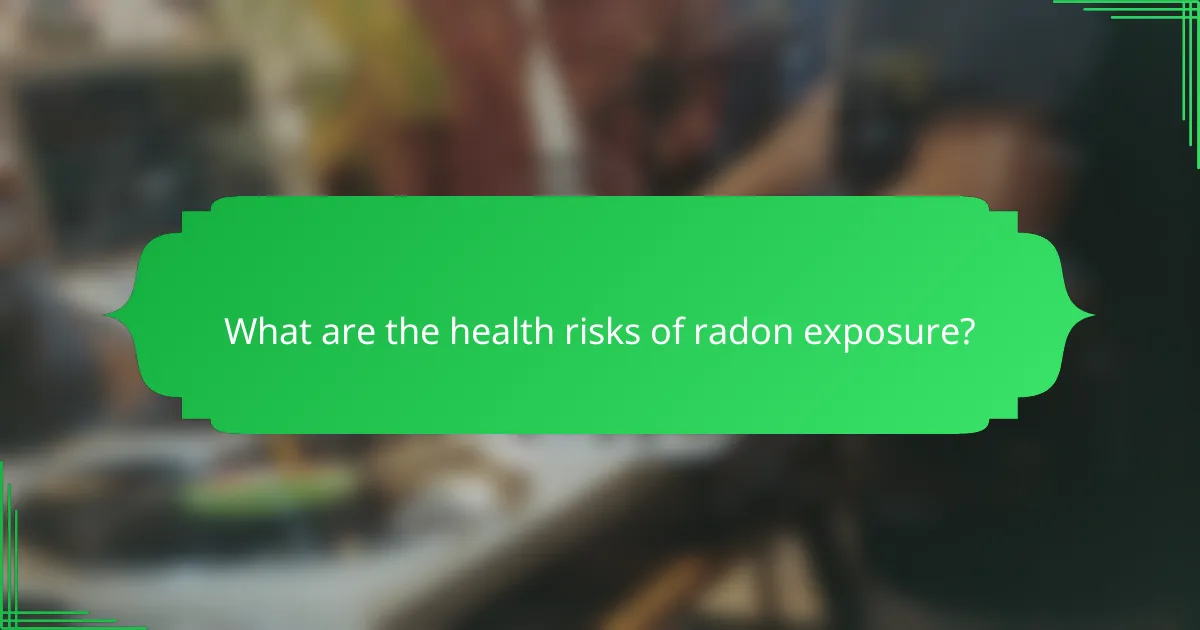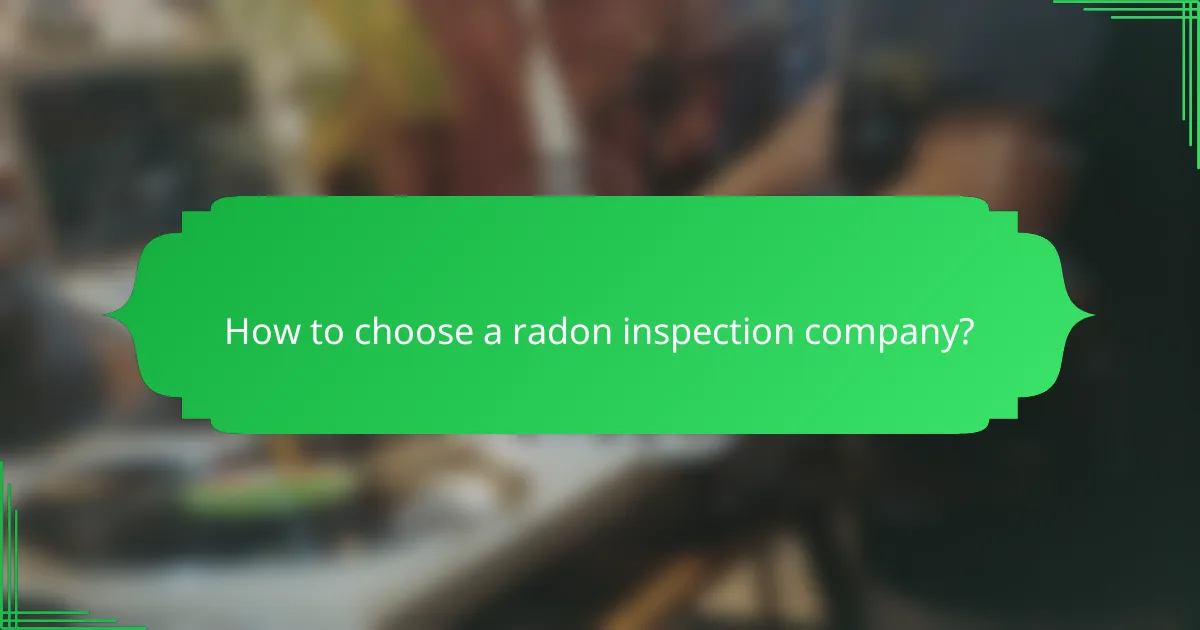Radon inspection is a crucial step in safeguarding your home from the dangers of this colorless, odorless gas, which can significantly increase the risk of lung cancer. By measuring radon levels through various testing methods, homeowners can identify potential hazards and take appropriate action. Understanding effective mitigation options, such as active soil depressurization and improved ventilation, is essential for creating a safer living environment.

How to measure radon levels in homes?
Measuring radon levels in homes is essential for ensuring safety, as radon is a colorless, odorless gas that can pose health risks. Homeowners can utilize various methods, including test kits, professional services, and continuous monitors, to accurately assess radon concentrations.
Using radon test kits
Radon test kits are an accessible option for homeowners to measure radon levels. These kits typically include a detector that you place in your home for a specified duration, often ranging from a few days to a week. After the exposure period, you send the kit to a laboratory for analysis.
When using a radon test kit, ensure it is certified by a recognized organization, such as the Environmental Protection Agency (EPA) in the United States. Follow the instructions carefully to avoid common pitfalls, such as placing the kit near windows or vents, which can skew results.
Professional radon testing services
Hiring a professional radon testing service can provide a more comprehensive assessment of radon levels in your home. These experts use advanced equipment and techniques to measure radon concentrations accurately. They can also identify problem areas and recommend mitigation strategies.
When selecting a professional service, look for certifications from reputable organizations. This ensures that the service adheres to established standards and protocols, providing reliable results and peace of mind.
Continuous radon monitors
Continuous radon monitors offer real-time tracking of radon levels in your home. These devices measure radon concentrations continuously and can provide alerts if levels exceed safe thresholds. They are particularly useful for long-term monitoring or in homes with fluctuating radon levels.
While continuous monitors can be more expensive than other testing methods, they provide detailed data over time, helping homeowners understand patterns and make informed decisions about mitigation. Ensure the device is calibrated and certified for accuracy.
Short-term vs long-term testing
Short-term testing typically lasts from 2 to 90 days and is useful for quick assessments, especially if you are considering buying or selling a home. However, short-term tests can be influenced by weather and seasonal changes, potentially leading to inaccurate readings.
Long-term testing, on the other hand, lasts more than 90 days and provides a more accurate representation of average radon levels in your home. This method accounts for variations in radon levels over time, offering a clearer picture of potential health risks. For reliable results, consider conducting both short-term and long-term tests, especially if initial tests indicate elevated radon levels.

What are the health risks of radon exposure?
Radon exposure poses significant health risks, primarily increasing the likelihood of lung cancer. It is a colorless, odorless gas that can accumulate in homes, particularly in basements and lower levels, leading to long-term health issues for occupants.
Lung cancer risk statistics
Radon is the second leading cause of lung cancer after smoking, contributing to thousands of deaths annually. The risk of developing lung cancer increases with higher radon levels; for instance, at levels of 4 pCi/L (picocuries per liter), the risk can rise significantly, especially for smokers.
According to the U.S. Environmental Protection Agency (EPA), about 1 in 15 homes in the United States is estimated to have elevated radon levels. Testing your home is crucial to assess your exposure risk.
Symptoms of radon exposure
Radon exposure typically does not cause immediate symptoms, making it particularly dangerous. Long-term exposure can lead to serious health issues, primarily lung cancer, but symptoms may not appear until the disease has progressed.
Common symptoms of lung cancer include persistent cough, chest pain, and difficulty breathing. If you suspect radon exposure, it is essential to conduct testing and consult a healthcare professional for further evaluation.

What are effective radon mitigation options?
Effective radon mitigation options aim to reduce radon levels in homes and buildings, ensuring a safer environment. Common methods include active soil depressurization systems, sub-slab depressurization, and ventilation improvements, each with specific applications and benefits.
Active soil depressurization systems
Active soil depressurization systems are designed to lower radon levels by creating a vacuum beneath the foundation of a building. This method involves installing a fan that draws air from below the structure, preventing radon from entering the living space.
When considering this option, ensure that the system is properly sealed and maintained to maximize effectiveness. Regular checks are essential to confirm that the fan is operational and that no new entry points for radon have developed.
Sub-slab depressurization
Sub-slab depressurization is a specific type of active soil depressurization that targets radon trapped beneath concrete slabs. It involves drilling a hole through the slab and connecting it to a fan that exhausts radon-laden air outside.
This method is particularly effective in homes with basements or crawl spaces. Homeowners should consult with a certified radon mitigation professional to ensure proper installation and compliance with local regulations.
Ventilation improvements
Ventilation improvements can help reduce radon levels by increasing air exchange within a building. This can be achieved through natural ventilation, such as opening windows, or mechanical systems that enhance airflow.
While this method may not eliminate radon entirely, it can significantly lower concentrations, especially in tightly sealed homes. Consider using energy recovery ventilators (ERVs) or heat recovery ventilators (HRVs) for efficient air exchange while maintaining indoor climate comfort.

How to choose a radon inspection company?
Choosing a radon inspection company involves evaluating their qualifications, customer feedback, and pricing. A reliable company should have the necessary certifications and a proven track record of satisfied clients.
Certifications and qualifications
Ensure the radon inspection company holds relevant certifications, such as those from the National Radon Proficiency Program (NRPP) or the National Radon Safety Board (NRSB). These certifications indicate that the inspectors are trained and knowledgeable about radon testing standards and protocols.
Additionally, check if the company complies with local regulations regarding radon inspections. Some states may have specific licensing requirements that the company must meet to operate legally.
Customer reviews and testimonials
Look for customer reviews and testimonials to gauge the company’s reputation. Websites like Yelp, Google Reviews, or the Better Business Bureau can provide insights into previous clients’ experiences.
Pay attention to recurring themes in the feedback, such as punctuality, thoroughness, and customer service. A company with consistently positive reviews is more likely to deliver a satisfactory inspection.
Cost considerations
Radon inspection costs can vary widely, typically ranging from $100 to $300, depending on the complexity of the inspection and the size of the property. Some companies may offer package deals that include follow-up testing or mitigation services.
When comparing costs, consider what is included in the price. A lower initial cost might not cover all necessary services, while a higher price may offer comprehensive testing and reporting. Always ask for a detailed estimate before making a decision.

What are the regulations for radon levels in residential areas?
Regulations for radon levels in residential areas primarily focus on ensuring safe indoor air quality. The U.S. Environmental Protection Agency (EPA) recommends taking action to reduce radon levels if they exceed 4 picocuries per liter (pCi/L) of air.
EPA guidelines for radon levels
The EPA guidelines suggest that homes should be tested for radon, especially in areas known for high radon levels. If radon levels are found to be 4 pCi/L or higher, mitigation measures should be taken to lower these levels.
Common mitigation techniques include installing a radon reduction system, which typically involves venting radon gas from beneath the home to the outside. Regular monitoring is advised to ensure that radon levels remain below the recommended threshold.
State-specific radon regulations
Many states have their own regulations regarding radon levels, which may be stricter than the EPA guidelines. For instance, some states require radon testing during real estate transactions or mandate disclosure of radon levels in homes for sale.
Homeowners should check with their state health department for specific regulations and resources. Some states also provide financial assistance or incentives for radon testing and mitigation, making it easier for residents to ensure their homes are safe.
